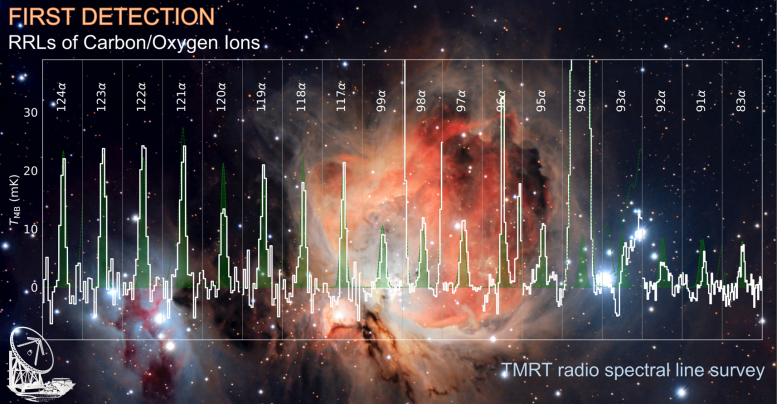
The white line shows the RRLs of ions of C and/or O detected by TMRT. The green areas are the modeled emission of ion RRLs. The green dotted lines are the modeled emission, taking into account all RLLs and molecular lines. The background is the image of the heart-shaped Orion nebula (M42), with Orion KL located within the lower-left bright region of M42, credit to Shawn Nielsen. Credit: SHAO
For the first time ever, a research team from the Shanghai Astronomical Observatory (SHAO) of the Chinese Academy of Sciences has successfully detected radio recombination lines (RRLs) of ions heavier than helium using the TianMa 65-m Radio Telescope (TMRT). These lines were identified as belonging to carbon and/or oxygen ions.
The findings were recently published in the journal Astronomy and Astrophysics.
Ionized gas is the most widely distributed component of interstellar gas and a valuable tool for determining the abundance of elements. Radio recombination lines (RRLs) can avoid the difficulties of optical line observations, since RRLs are usually optically thin and have well-understood emission mechanisms.
However, detected RRL emitters have nearly all been neutral atoms so far. Only two RRL transitions (121α and 115α) of helium ions in planetary nebulae have been previously reported. Line blending makes the RRLs of atoms heavier than helium difficult to spectrally resolve. In contrast, the RRLs of ions are not generally blended with RRLs of neutral atoms, making the former a much more powerful tool for measuring abundance.
The researchers made this new discovery while searching for interstellar emission lines as part of an ongoing TMRT spectral line survey toward Orion KL. While identifying the Ka-band (26-35 GHz) spectral lines of Orion KL, they found several broad line features that could not be assigned to any molecular species nor to the RRLs of atoms.
“These line features have weak intensities but are already significant enough to be distinguished due to the high sensitivity of the spectrum. Because their line widths are similar to those of H/He RRLs, we realized that those line features could be RRLs of ions,” said Dr. Liu Xunchuan from SHAO, corresponding and first author of the study.
To confirm this, the astronomers conducted follow-up Ku-band (12-18 GHz) observations using TMRT to search for signals of ion RRLs at the expected frequencies, and eight more alpha lines (RRLs with Δn=1) of ions were detected.
In addition, they found marginal signals of alpha lines in the Q band and beta lines (Δn=2) in the Ka band. They compared the spectra obtained on different days and found that the frequencies of the line features remained unchanged when corrected for the motion of the Earth, confirming that the ion RRLs originated from space.
In total, tens of RRLs of interstellar ions were detected by TMRT, and many of them are not blended with any transitions of molecules nor with RRLs of atoms. The lines detected by TMRT are more than 20 kilometers per second bluer than the expected frequencies of helium ion RRLs and were thus assigned to ions heavier than helium. The abundance of the doubly ionized elements associated with those ion RRLs was accurately determined to be 8.8 parts per 10,000, which is consistent with the value of carbon/oxygen estimated from optical/infrared observations.
Previously, RRLs were commonly defined as radio spectral lines, caused by transitions of high-n levels of atoms, that appeared after the recombination of singly ionized ions and electrons. But now, the researchers have detected tens of unblended ion RRLs simultaneously.
“Such a new technique would be very valuable to study the abundances of carbon and oxygen, the most important constituents of carbon monoxide and interstellar complex organic molecules, in the inner Galaxy, where optical observations are very difficult,” said Prof. Neal J. Evans II from the University of Texas at Austin.
SHAO researchers see this new discovery by TMRT as the first of many. “The ongoing TMRT spectral line survey towards Orion KL and other Galactic objects will reach an unprecedented line sensitivity, which will lead to more new discoveries such as RRLs of heavy ions, new transitions of molecular lines, and even new molecule species,” said Liu Tie, a researcher in SHAO and co-corresponding author of the study.
Reference: “First detection of radio recombination lines of ions heavier than helium” by Xunchuan Liu, Tie Liu, Zhiqiang Shen, Paul F. Goldsmith, Neal J. Evans II, Sheng-Li Qin, Qiuyi Luo, Yu Cheng6, Sheng-Yuan Liu, Fengyao Zhu, Ken’ichi Tatematsu, Meizhu Liu, Dongting Yang, Chuanshou Li, Li Chen, Juan Li, Xing Lu, Qilao Gu, Rongbing Zhao, Bin Li, Yajun Wu, Weiye Zhong, Zhang Zhao, Jinqing Wang, Qinghui Liu, Bo Xia, Li Fu, Zhen Yan, Chao Zhang, Lingling Wang, Qian Ye, Hongli Liu, Chao Zhang, Fengwei Xu and Dipen Sahu, 7 February 2023, Astronomy and Astrophysics.
DOI: 10.1051/0004-6361/202345904

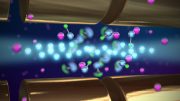
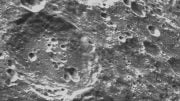
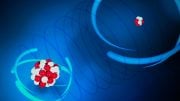
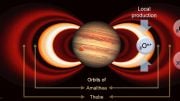

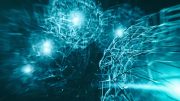

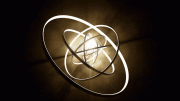
Be the first to comment on "Astronomers Have Detected RRLs of Carbon/Oxygen Ions for the First Time"